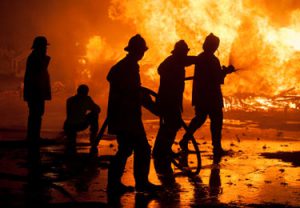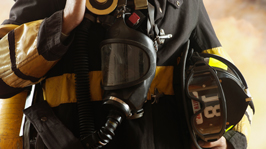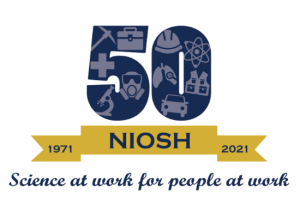Protecting Firefighters
Posted on by
The National Institute for Occupational Safety and Health (NIOSH) has a long history of working to protect firefighters. Firefighting is an inherently dangerous and vitally important occupation. The United States Fire Administration reported that 1,955 firefighters died in the line of duty from 1998-2019. In addition to injuries and deaths occurring on the fireground, firefighters are at risk of cancer and other illnesses. NIOSH has multiple comprehensive projects and programs that aim to improve firefighter health and safety, including those that focus on personal protective equipment, and wildland firefighters.
Fire Fighter Fatality Investigation and Prevention Program (FFFIPP)
In 1998, Congress recognized the need to address the national problem of line of duty firefighter deaths and funded NIOSH to implement a firefighter safety initiative. NIOSH created the FFFIPP to conduct independent investigations of firefighter line of duty deaths (LODD) with a specific focus of identifying key contributing factors and developing recommendations that if implemented can help prevent deaths and injuries. A decision flow chart is used to determine which investigations to undertake. The cooperation of the involved fire department is enlisted before beginning an investigation. Investigations are divided by cause into medical events and traumatic injury LODD. In the 23 years since the program began, the FFFIPP investigated approximately 39 percent of all firefighter deaths and conducted 769 investigations (443 traumatic and 326 medical).
The goal of the FFFIPP program is to learn from firefighter fatalities and prevent similar events. For every investigation NIOSH produces a FFFIPP LODD report describing the incident and providing prevention recommendations. To prevent future incidents, it is important that the recommendations produced are applied by fire departments and firefighters throughout the country. FFFIPP LODD reports are available online and are searchable by state, incident year, and whether the death was related to a traumatic injury or a medical cause.
Medical LODDs
National Fire Protection Association data show that sudden cardiac death is the most common type of LODD for firefighters. Examples of causes of death that may be investigated by the medical team include heart attack, stroke, aortic dissection, heat stroke/hyperthermia, rhabdomyolysis, etc. FFFIPP investigations assess personal and workplace factors that may have contributed to the death. Personal factor evaluation examines the individual’s medical history, risk factors related to the cause of death, and autopsy findings. Workplace factor evaluation includes review of:
- work activities preceding the death
- departmental training policies relevant to the cause of death
- fire department cardiovascular and other health screening efforts
- fire department fitness and wellness programs
The FFFIPP final report includes tailored recommendations to reduce the risk of future similar fatalities based on the results of the personal and workplace factors review.
Traumatic Injury LODDs
In addition to medical deaths, the FFFIPP program investigates fireground and non-fireground fatalities resulting from a variety of circumstances, such as:
- Structural collapses, entrapment/lost, and falls
- Struck-by motor vehicles while on scene
- Emergency vehicle incidents (e.g., during response, return to station)
- Training incidents
 SCUBA diving incidents
SCUBA diving incidents
NIOSH experts in personal protective equipment (PPE) and respirators also assist with investigations where the function or performance of PPE and respiratory protective equipment may have been a contributing factor. They conduct in-depth testing and evaluation related to the performance of the protective clothing and self-contained breathing apparatus (SCBA) as well as associated maintenance programs.
FFFIPP Report Recommendations
In 2019, NIOSH published an article summarizing FFFIPP investigations from 2006-2014. Over this time period, the most common traumatic injury LODD events investigated were motor vehicle related (23%), which included vehicle collision/rollover (13%) and struck-by a vehicle (10%). This was followed by caught/trapped (16%), structure collapse (13%), and lost/disoriented (10%). Since traumatic injury LODD have multiple causes, recommendations are dispersed among several different areas related to the nature and cause of the injury. The three leading recommendations from traumatic FFFIPP reports for 2006–2014 were: 1. Training, 2. Standard operating procedures/standard operating guidelines, and 3. Incident command.
For medical fatality investigations, 89% were cardiovascular related which includes heart attacks and strokes. The leading recommendations from these NIOSH FFFIPP medical investigations between 2006 and 2014 were: 1. Medical screening, 2. Fitness and wellness, and 3. Medical clearance for duty. Recommendations for prevention of hyperthermia, heat stress, and rhabdomyolysis deaths include heat mitigation strategies, medical screening for conditions that impact thermoregulation, increased education on these conditions to encourage early recognition and treatment, and scheduling of training events in cooler times of the day and year when possible.
Consensus Standard Contributions
The FFFIPP has made significant contributions to several of the National Fire Protection Association’s (NFPA) consensus standards through participation on technical committees. Based on NIOSH FFFIPP investigations, NFPA 1981: Standard on Open-Circuit Self-Contained Breathing Apparatus (SCBA) for Emergency Services was modified to increase heat and flame testing requirements for the integrity of the facepiece lens, add a new voice communication intelligibility requirement, and increase the end of service time indicator from 25 to 33 percent of the cylinders rated capacity to alarm when the remaining service time has been reached. This change was made to provide SCBA users additional time to exit a scene. Other modifications to NFPA 1981 were related to actions of firefighters when removing a regulator and the addition of pneumatic data logging. NIOSH recommended NFPA 1852: Selection Care and Maintenance of SCBA include considerations for breathing air compressor and cascade upgrades when considering purchasing higher pressure SCBA. NIOSH also recommended additional language for NFPA 1989: Breathing Air Quality for Fire and Emergency Services to protect operators during routine filling (fragmentation containment). NIOSH contributed to the development of NFPA 1802: Standard on Two-Way, Portable RF Voice Communications Devices for Use by Emergency Services Personnel in the Hazard Zone. This new standard focused on making portable radios more environmentally rugged and enhancing their overall performance so that radios will not inadvertently turn off and high temperature survivability is improved. These are just a few examples of the changes that were made to NFPA consensus standards as a result of findings from FFFIPP investigations and participation on NFPA technical committees.
National Firefighter Registry (NFR): Understanding and Reducing Cancer
In 2018, Congress established the Firefighter Cancer Registry Act of 2018 that directed CDC to set up a voluntary registry of firefighters that will track links between their workplace exposures and cancer. This will help address unanswered questions about cancer in the U.S. fire service. NIOSH will take the lead in establishing the registry. NIOSH hopes to use data from the NFR to examine trends in cancer patterns, exposures, demographic characteristics, protective practices, and workplace characteristics to help guide future interventions and best practices. The registry will be available to anyone who has ever served as a U.S. firefighter in any capacity (e.g., volunteer, career, part-time, wildland, investigator) regardless of cancer diagnosis. NIOSH expects NFR enrollment to begin in 2022. Those interested in following the progress of the NFR can subscribe to the quarterly newsletter.
Firefighter Resources
NIOSH engages in many activities to help improve the health and safety of firefighters. See the Fire Fighter Resources webpage for a complete list. We would like to hear any feedback on our activities, but we are particularly interested in feedback on our longstanding FFFIPP and investigation reports. What changes could we make to these reports to help your department make better use of them?

This blog is part of a series for the NIOSH 50th Anniversary. Stay up to date on how we’re celebrating NIOSH’s 50th Anniversary on our website.
Jeff Funke, MS, CSP, is a Team Lead in the Surveillance and Field Investigations Branch in the NIOSH Division of Safety Research
Judith Eisenberg, MD, MS, is the lead of the Firefighter Fatality Investigation and Prevention Program’s Medical Team in the NIOSH Division of Field Studies and Engineering
Kenny Fent, PhD, CIH, is an Industrial Hygienist and Lead of the National Firefighter Registry in the Field Research Branch of the NIOSH Division of Field Studies and Engineering
Matt Bowyer is an Investigator/Engineer and lead of the Firefighter Fatality Investigation and Prevention Program’s Trauma Team in the Surveillance and Field Investigations Branch in the NIOSH Division of Safety Research
Steve Miles is an Investigator/Safety and Occupational Health Specialist in the Surveillance and Field Investigations Branch in the NIOSH Division of Safety Research and a retired Battalion Chief of Safety with the Virginia Beach Fire Department
Posted on by

